“Sharing Time: Keeping Promises,” Friend, May 2000, 13
Sharing Time:
Keeping Promises
And if ye do always remember me ye shall have my Spirit to be with you (3 Ne. 18:7).
Melinda was almost eight years old, and she was eager for her birthday to come, because she would be baptized and receive the gift of the Holy Ghost.
Her mother and father were pleased that Melinda wanted to be baptized. They knew that she was ready to make a covenant—a sacred promise—with Heavenly Father.
She had already practiced making and keeping promises. When her mother asked her to read to her little brother each evening while dinner was being prepared, Melinda promised to do it—and she did! And each time she went to her friend’s house to play, she promised her parents that she would be home on time. She kept that promise, too.
Most of all, Melinda was trying to always remember Jesus. When she was tempted to pretend that she didn’t hear her father call her to come home, she thought, What would Jesus want me to do? and quickly ran home.
Yes, Melinda knew how to keep her promises. Now she was eager to make the promise to Heavenly Father to keep His commandments and to take upon her the name of His Son and always remember Him. She knew that when she was baptized and made that promise, He would promise her that she would always have His Spirit to be with her.
In family home evening, her father had taught from the Book of Mormon about the Liahona, a special compass the Lord gave to Lehi’s family to guide them through the wilderness (see 1 Ne. 16). The Liahona worked only when the people were faithful and diligent in keeping the commandments (see 1 Ne. 16:28). When they murmured (complained) or were unkind, it would not show them the way to go. Melinda knew that she must also be faithful and diligent in keeping her baptismal covenant so that she could have the Holy Ghost to guide her. She knew that if she kept her promise, Heavenly Father would keep His promise.
Melinda’s father taught, “Heavenly Father loves all of His children, and He wants each of us to live with Him again some day. He knows us all—our names, our talents, and the feelings we have in our hearts. He wants us to be happy. He has promised to send the gift of the Holy Ghost to us after we are baptized. The Holy Ghost will bring guidance from Heavenly Father to help us make good choices. If we listen and obey, we will be happy and be worthy to return to live with Heavenly Father. That is His promise.”
Activity: “The Liahona and the Holy Ghost” Roller Box
-
Cut a window in one side of a small, empty box, like a gelatin box.
-
Lay the box, window-side up, on a 10″ (25 cm) square of colored paper or aluminum foil. Fold the paper around the box, then cut an X across the window and fold the paper inside it (see illustration).
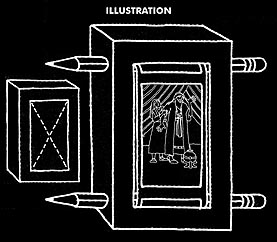
-
Push a pencil through the sides of the box at the top, and another pencil through the sides at the bottom (see illustration).
-
Color, then cut out the pictures on page 12. Mount them in order on a long strip of paper narrow enough to just fit inside the window of the box; cover with clear wrapping tape (optional).
-
Tape the top of the picture strip to the top pencil, and the bottom of the strip to the bottom pencil. Then roll the pictures from bottom to top and tell the story, or read it directly from the scripture references.
-
Optional: Make additional pictures of other times when Heavenly Father made promises to His people (for example, Mosiah 24 or Moses 6:32–34 and Moses 7:13). Be sure to tell what promise He made and how the promise was fulfilled. This might be fun to do in family home evening.

1. Lehi obeyed God’s commandment to take his family into the wilderness. One morning, the Lord provided a ball of curious workmanship, which Lehi found at the door of his tent. (See 1 Ne. 2:2; 1 Ne. 16:10.)
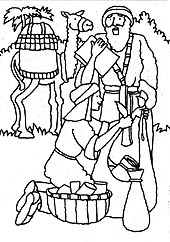
2. Within the ball were two spindles that pointed the way they should go. Obedient, they folded up their tents and traveled for many days, following the directions on the ball. (See 1 Ne. 16:12, 16.)
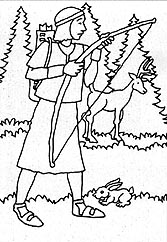
3. One day as Nephi went to hunt for food, his bow broke. Without his bow, he was unable to get any food for the family. Hungry and unhappy, his brothers and even his father complained. (See 1 Ne. 16:18, 20.)

4. Nephi made a new bow of wood. Then he asked his father where to look for food. Lehi prayed about it, and the Lord told him to look at the ball. (See 1 Ne. 16:23, 25–26.)

5. The pointers in the ball worked when Lehi and his family were faithful, diligent, and obedient. Writing on the ball taught them about the ways of the Lord. Nephi now followed its directions and found food for the family. (See 1 Ne. 16:28–31.)
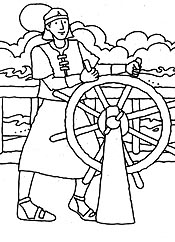
6. They came to the seashore, and the Lord commanded Nephi to build a ship. When it was completed, the family packed up their things and went out onto the ocean. (See 1 Ne. 17:6, 8; 1 Ne. 18:4–6, 8.)
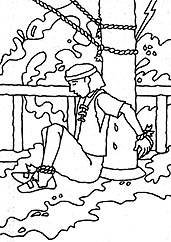
7. Laman and Lemuel began to complain again. When they tied Nephi up, the ball stopped working. A huge storm blew, and the boat was driven back on the water. (See 1 Ne. 18:11–14.)

8. Nephi continued to pray to the Lord. When Laman and Lemuel saw that they might drown, they untied their brother. The storm ended, and the compass worked again. They sailed many more days and finally reached the promised land. (See 1 Ne. 18:15–16, 21–23.)
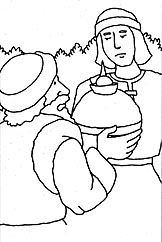
9. The compass, or Liahona, worked when the people kept the Lord’s commandments. When they were unkind to one another, or complained, or did not pray, it did not guide them. (See Alma 37:38–41.)
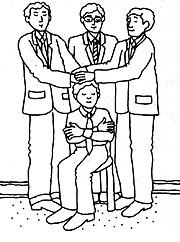
10. When we are baptized and confirmed members of the Church, we are given the gift of the Holy Ghost to guide us. But like the Liahona, the Holy Ghost will not do so unless we keep our part of the baptismal covenant. If we do, Heavenly Father has promised that the Holy Ghost will always be with us. (See 3 Ne. 18:7.)
Sharing Time Ideas
(Note: CS = Children’s Songbook)
1. Work with the music leader for this Sharing Time. Have her/him ask the children to touch their ears when they hear another name for the Holy Ghost as you sing the first 2 lines of “The Still Small Voice” (CS, pp. 106–107). Take responses. Sing the same 2 lines again, and ask the children to fold their arms when they hear 2 things the Still, Small Voice will do for them. Take responses. Have the children sing the first 2 lines with you. Tell of an experience when the Holy Ghost guided and saved someone from evil. (E.g., President Harold B. Lee’s experience found in Enrichment Activity 1, Primary 7 manual, p. 125.) The music leader should now have the children stand and sing again the part of the song they have just learned.
Ask the children to sit when they hear 4 more things the Holy Ghost will do. Sing the next 2 lines, and take responses. Have the children sing those lines with you.
Tell them that one of the most important words in this song is repeated 4 times. When they hear that word, they should put their hands over their hearts. Sing the last 2 lines of the song, take responses, and have them sing those lines with you.
Share one of your own experiences with the Holy Ghost, or tell the story “The Feeling” (Friend, Feb. 1998, pp. 30–31). Let the children draw a picture of either of the stories or an experience they have had when the Holy Ghost helped them. Suggest that they share their pictures, the stories, and the song with their families, to help them remember to listen to the Holy Ghost.
2. Have an all-music Sharing Time. Draw a Liahona (see Gospel Art Kit, #302, “Book of Mormon Scripture-Story Grab Bag,” Friend, Feb. 2000, p. 25, for ideas) and make 8 copies of it. On the back of each picture, write a song title and a question that can be answered with the words of the song. Invite a child from each class to choose a Liahona, read the song title aloud, and answer the question with the help of his/her class. (The children should sing through the song in their minds to find the answer.) Then have all the children sing the song to check the answer. Use “boys sing,” “girls sing,” “all sing,” “teachers sing,” “stand and sing,” etc., to add variety to each song. Song titles—all from the CS (page numbers in parentheses)—and questions:
“When Jesus Christ Was Baptized” (102) How did the Holy Ghost descend?
“I Like My Birthdays” (104) If I listen carefully, what will I have that I need most?
“The Church of Jesus Christ” (77) I believe in the Savior, Jesus Christ. What will I do with His name?
“Seek the Lord Early” (108) What will the Savior help me to know?
“The Still Small Voice” (106–107) What will the Holy Ghost do?
“The Holy Ghost” (105) The Holy Ghost is what kind of friend?
“I Know My Father Lives” (5) “The Spirit whispers this to me and” what?
“I’m Trying to Be like Jesus” (78–79) “I try to listen as the still small voice whispers,” what?
“Faith” (96–97) “Faith is strengthened; I feel it grow” when?
Write your own questions for additional songs, or let the children suggest songs and questions.
3. Post the following 4 sets of scriptures on a chalkboard or poster. Give each child a paper titled “Heavenly Father Keeps Promises.” Have them fold it into 4 sections, one for each set of scripture references. The children could work individually, in pairs, or as classes. Say that Heavenly Father has always kept His promises. Ask them to read each set of scriptures to discover God’s promise, to whom it was made, and how and when it was fulfilled. Have the children write the answers on their papers, then take turns reporting their findings to the whole Primary. Sing a song from the CS that correlates with each scripture story. Possible scriptures and songs (page numbers in parentheses):
2 Ne. 25:21; 2 Ne. 27:6–9; JS—H 1:30, 34, 59 / “An Angel Came to Joseph Smith” (86) and/or “The Golden Plates” (86) [the coming forth of the Book of Mormon]
Abr. 2:9–11; Doctrine and Covenants, OD 2 / “The Priesthood Is Restored” (89) or “We’ll Bring the World His Truth” (172–173) [the priesthood to be taken to all nations through Abraham’s posterity]
1 Ne. 2:19–20; 1 Ne. 18:23 / “Nephi’s Courage” (120–121, esp. v. 2) [Nephi to receive a promised land]
John 14:26; Acts 1:5; Acts 2:1, 4 / “The Holy Ghost” (105) [the Holy Ghost is promised to the Apostles]
Heavenly Father has promised that if we keep His commandments, we will have His Spirit [the Holy Ghost] with us. Conclude with a brief experience of when the Holy Ghost helped you. Bear your testimony that Heavenly Father does keep His promises to us when we keep our promises to Him.
For younger children: Use flannel-board figures, or pictures from the Gospel Art Kit, to tell the stories above. Let the children take turns retelling them and placing the flannel-board figures themselves. If space allows, divide the children into groups and let them move from one flannel board to another, hearing, then retelling the stories. Then discuss each story to help the children understand that Heavenly Father keeps His promises to us when we keep our promises to Him.
4. “Who Am I?” On slips of paper, write 5 clues about a person who had important experiences with the Holy Ghost. For each person, have 5 children each read a different clue aloud to the rest of the Primary. Let the children write down the name of the person they think it is; have another child look up the scripture(s) for any question that arises. Choose 5 new clue-readers for each scripture person. Possibilities:
NEPHI
-
This person built a temple (see 2 Ne. 5:16).
-
He saw the same vision his father saw (see 1 Ne. 11).
-
He had three older brothers (see 1 Ne. 2:5).
-
He built a boat (see 1 Ne. 17:8; 1 Ne. 18:3–4).
-
He was tied up by his brothers Laman and Lemuel (see 1 Ne. 18:10–11).
ALMA THE YOUNGER
-
When this person was younger, he rebelled against the Church (see Alma 36:heading, Alma 36:6).
-
His father prayed for him (see Mosiah 27:13–14).
-
He went on a mission and worked hard to help people be baptized so that they could have the Holy Ghost (see Alma 13:27–28, 31).
-
He was imprisoned while on his mission (see Alma 14:1–4, 16–17).
-
Amulek was told in a vision to invite this man into his (Amulek’s) house and feed him (see Alma 8:20–21).
ETHER
-
This prophet lived in the days of Coriantumr, the king over all the land (see Ether 12:2).
-
This man was a Jaredite (see Ether 1:6–32).
-
From morning to evening he taught the people to believe in God (see Ether 12:2–3).
-
The people wouldn’t believe him because they could not see the things he prophesied about (Ether 12:5).
-
He was so filled with the Spirit that he couldn’t be kept from teaching (see Ether 12:2).
NEPHI AND LEHI
-
These brothers were great missionaries (see Hel. 3:21; Hel. 5:4, 17–19).
-
Their father’s name was Helaman (see Hel. 3:20–21).
-
He named them after two great prophets in the Book of Mormon (see Hel. 5:6).
-
While they were on a mission, they baptized eight thousand Lamanites (see Hel. 5:19).
-
They were thrown into prison, but when the people came to kill them, the two brave missionaries were protected by a circle of fire (see Hel. 5:21–25).
JOSEPH SMITH
-
This man saw an angel (a “messenger sent from … God”) (see JS—H 1:30, 33).
-
He translated an important book (see D&C 17:5–6).
-
He was shot to death while in prison (see D&C 135:1).
-
He saw God the Father and His Son, Jesus Christ (see JS—H 1:17, heading).
-
He was the first prophet and President of The Church of Jesus Christ of Latter-day Saints (see Doctrine and Covenants, Explanatory Introduction).
5. Additional Friend resources: “In the Quiet of a Thicket” (July 1998, pp. 35–37); Making Friends (Mar. 1998, pp. 20–22); “I Can Repent” (Feb. 1996, p. 26).
Illustrated by Shauna Mooney Kawasaki